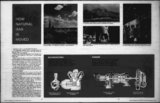| OCR Text |
Show in the Peraiian Basin of west Texas and the San Juan area of northern New Mexico, the pipelines are mostly short field lines so the patrols move by foot, truck or, when the roads are muddy, on horseback. . But El Paso Natural has hundreds of miles of pipelines that cross the wooded slopes of Washington and Oregon where pipeline patrols can move in a faster way. These pipelines are watched by airplane. In the Northwest, where pipeline roads arefew and sometimes far between, where steep cliffs and rugged mountains exist, the Company keeps one plane and two men flying the , pipeline from Gallup, New Mexico, to Sumas, Washington. Flying over the pipeline gives an observer a better perspective. From above, he not only can see clearly the pipeline right- Via Viqj o oriwt vipw nff tn Anrh side. Since the same observer usually flies the same routes every month he becomes familiar with the entire pipeline system and is better able to predict when maintenance will be needed, thus maintaining the pipeline in perfect condition. These flying patrols look for sunken spots over the pipeline, pipe exposed by a flooding stream, fallen timber on the or eroded ground in farmland. Some of El Pasok pipelines are marked with mileposts that can be read from the air so if any of these problems are spotted, the observer can - radio the exact location , to thedistrict crew can be dispatched promptly. THESE men are loading a "pig" in the pipeline to clean the pipe's interior. The pipeliners' "pig" is a metal instrument with stiff wire brushes. right-of-wa- y, ry v ( As an example of how rugged some of this pipeline country is, a district in southern Washington has 325 miles of pipeline but only 14 miles of it can be driven by car or track. When maintenance has to be nerformed on this section, the work crews drive to the nearest pointbnstate drcounty mgnwaysTtheir" walk five or six miles to the pipeline, carrying with them all the tools and equipment necessary to do the job. . - - - An air patrol leaves Salt Lake City every other week and flies north, across the mainline and all of its branch lines to the Canadian border, and back again. Other pipelines are inspected by air once every month, although district men are constantly y on other maintenance tasks and observriding the right-of-wa- ing the pipeline. -- But pipeline maintenance is not ., confined inspection. Sometimes solid and liquid particles will accumulate in a pipeline, usually in those lines close to the production fields, and these pipelines are cleaned periodically, : -- patrol plane is a familiar sight in the Northwest This Cessna y which is in a forest 210 is flying above pipeline EL PASO'S right-of-wa- instrument with stiff wire brushes that This is a barrel-shape- d fits snugly inside the pipe. A section of the pipeline, usually . x o t .1' t 1 i i m uuuk-uu cue uisww-clgUl Ul ten liuics, u iauiaicu- -i feet apart with sudsy water between the pigs. The pigs are forced down, the pipeline by gas pressure, thoroughly cleaning the inside walls. ... . . u v; Incidentally,' the name of this cleaning instrument comes. ffomHffiesqu by low gas pressure behind it. . . Pigging a pipeline, as this work is called, is scheduled so it will, not interfere with gas deliveries. To clean an eight-mil- e section of pipe takes 650 pounds of detergent and 21,000 gallons of water. 30-in- ch That's a lot of sudsy water but it gets the job done. And by washing out the pipelines when they need it, flying regular patrols over the pipeline system, and providing prompt maintenance when it's called for,. El Paso Natural keeps its pipelines in top condition, allowing gas to flow constantly from the production fields to gas consumers. Natural's maintenance crews are not confined to mainline Rough, rocky terrain like this must be traveled in many parts of the Company's system so technicians can do routine repairs at some of El Paso's isolated microwave repeater stations. EL PASO right-of-wa- y. 9 Special Supplement by El Paso Natural Gas Company. (Adv.) |































































